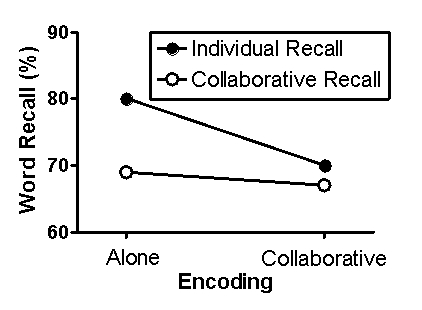Use the following to answer questions
Scenario I
Scenario I is based on and provides fabricated data consistent with the following study:
Barber,S.J. ,Rajaram,S. ,& Fox,E.B.(2012) .Learning and remembering with others: The key role of retrieval in shaping group recall and collective memory.Social Cognition,30(1) ,121-132.doi:10.1521/soco.2012.30.1.121
In a typical experiment on collaborative memory,participants first encode information individually and later attempt to recall the information either individually or in a small group (collaboratively) .While the recall of the collaborative group is better than that of any individual,the summed recall of individuals typically is better than the recall of the collaborative group.This is a phenomenon termed collaborative inhibition.Barber,Rajaram,and Fox (2012) investigated this phenomenon during both the encoding and retrieval stages of memory.
Participants created sentences out of a word bank,which provided for the opportunity to encode this information.After completing this task,participants engaged in an unrelated task-solving mazes-for 10 minutes.Then,in a surprise memory test,they were asked to recall as many words from the word bank as possible (retrieval) .
Participants were randomly assigned to one of four groups.In the first group (Alone-Alone) ,participants were studied individually during both the encoding and retrieval phases of the experiment.In the second group (Alone-Collaborative) ,participants were studied individually during the encoding phase and studied as part of a three-member team (triad) during the retrieval phase.In the third group (Collaborative-Alone) ,participants were studied in a triad during the encoding phase but individually during the retrieval phase.Finally,in the fourth group (Collaborative-Collaborative) ,participants completed both phases of the experiment as part of a triad.
Fabricated results illustrating the major finding of Barber et al.(2012) are presented in Figure 6.1.This figure shows the percentage of words from the word bank accurately recalled as a function of group.For the two groups that experienced the retrieval phase individually,scores represent the summed retrieval of the individuals comprising the group.For the two groups that experienced the retrieval phase as part of a triad,scores simply represent the collaborative performance.
Figure 6.1 
-(Scenario I) It can be inferred that the experimenters inserted the maze task between encoding and recall to:
Definitions:
Louis Henry Sullivan
An American architect, regarded as the "father of skyscrapers" and mentor to Frank Lloyd Wright, who emphasized form following function.
Rodin
Auguste Rodin was a French sculptor known for his expressive and realistic works in bronze and marble, such as "The Thinker."
Sculpted Surface
A surface that has been shaped, carved, or modified to feature a three-dimensional pattern or form, often found in art and architecture.
Artistic Movement
A trend or style in art with a specific common philosophy or goal, shared by a group of artists during a restricted period of time.
Q88: Most forgetting occurs soon after the occurrence
Q101: Animals will not work to self-administer LSD.
Q105: The technical term for a Skinner box
Q108: A business executive was so occupied with
Q114: All species are biological predisposed to learn
Q165: Slot machines pay off on schedules that
Q173: Three weeks ago,Sandra came home to find
Q205: Lots of cash in hand always makes
Q333: The inability to retrieve information acquired before
Q340: Which statement would a person MOST likely